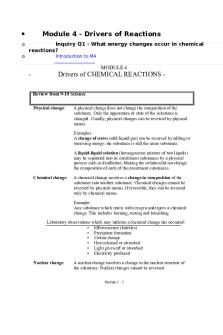Module 2 Study Guide PDF

| Title | Module 2 Study Guide |
|---|---|
| Author | Allycia Cundiff |
| Course | Family Nurse Practitioner |
| Institution | Texas Wesleyan University |
| Pages | 2 |
| File Size | 38.3 KB |
| File Type | |
| Total Downloads | 93 |
| Total Views | 140 |
Summary
Download Module 2 Study Guide PDF
Description
Module 2 Study Guide Chapter 5, 6, 7, 1. What is an adverse drug reaction? Any noxious, unintended, and undesired effect that occurs at normal drug doses 2. Who is at risk for an ADR? Elderly and the very young or someone with severe illness 3. What is a drug side effect and when does it usually occur? A nearly unavoidable secondary drug effect produced at therapeutic doses. Can develop soon after drug is initiated or not until drug has been taken for weeks or months 4. What is a self -limiting side-effect? 5. Define toxicity: the degree of detrimental physiologic effects caused by excessive drug dosing 6. What role does the immune system have in allergic reactions? An allergic reaction is an immune response. There must be prior sensitization of the immune system for an allergic response to occur. 7. What drug class is responsible for most allergic reactions? Penicillin’s 8. Differentiate idiosyncratic, paradoxical, and iatrogenic effects: a. Idiosyncratic: an uncommon drug response resulting from a genetic predisposition b. Paradoxical: the opposite of the intended drug response c. Iatrogenic: disease produced by drugs, essentially identical to naturally occurring pathology 9. Who is at risk for developing a physical dependence to a drug? People on long-term use of opioids, alcohol, barbiturates, and amphetamines. 10. Define teratogenic and give 2 examples of drug classes in this category: Drug-induced birth defect. Examples include ACE inhibitors, and acne medication isotretinoin. 11. Explain the hepatotoxicity between alcohol and acetaminophen: When acetaminophen is taken in excessive doses or taken with two or three alcoholic beverages, severe liver injury can result. 12. What are the symptoms of liver injury? Jaundice, dark urine, light-colored stools, nausea, vomiting, malaise, abdominal discomfort, and loss of appetite. 13. What is a QT interval drug and what possible arrhythmias can result from their use? Drugs that prolong the QT interval on ECG. Can create torsades de pointes and v fib. 14. What can prescribers do to minimize ADRs? Select the least harmful drug, balance potential risks with probably benefits. 15. What is a black box warning? Strongest safety warning a drug can carry. Alerts prescribers to potentially severe side effects. 16. If a patient experiences an ADR what should the provider’s response be? Identify the reaction and when, how, why it appeared. 17. What factors influence individual variation in drug response? Body weight and composition, age, pathophysiology, and tolerance. 18. Explain why infants have variable drug responses: because of their organ immaturity 19. Explain why elderly have variable drug responses: because of their organ degeneration, or increased severity of illness, multiple pathologies, treatment with multiple drugs etc. 20. Understand the pathophysiology behind variation in drug responses: Physiologic alterations can modify drug responses. Examples are kidney disease, live disease, acid-base imbalance, and altered electrolyte status.
21. Define and differentiate the 3 types of drug tolerance that occurs: a. Pharmacodynamic tolerance: associated with long-term administration of drugs such as morphine and heroin. Results from adaptive processes that occur in response to chronic receptor occupation. b. Metabolic tolerance: resulting from accelerated drug metabolism c. Tachphylaxis: reduction in drug responsiveness brought on by repeated dosing over a short time. 22. Define bioavailability and explain what type of medications are affected the most: Ability of the drug to reach the systemic circulation from its site of administration. Occurs primarily with oral preparations. 23. Understand the different issues related to absorption variability in the GI track: changes in gastric Ph, diarrhea, constipation, and food in the stomach can cause variable absorption. 24. How does gender and diet affect drug variation responses? 25....
Similar Free PDFs

Module 2 Study Guide
- 6 Pages

Module 2 Study Guide
- 10 Pages

Module 2 Study Guide
- 2 Pages

Module 2 Study Guide
- 8 Pages

Module 7 study guide
- 5 Pages

Module 5 Study Guide
- 6 Pages

Study Guide Module 6
- 5 Pages

Module 4 study guide
- 36 Pages

Module 1 study guide
- 14 Pages

Module 1 Study Guide
- 29 Pages

Module 3 Study Guide
- 3 Pages

Module 6 Study Guide
- 4 Pages

Module 5 Study Guide
- 14 Pages

Module 3 Study guide
- 2 Pages

Exam 2 Module 5-8 Study Guide
- 14 Pages

Module 3 Study Guide LAB
- 3 Pages
Popular Institutions
- Tinajero National High School - Annex
- Politeknik Caltex Riau
- Yokohama City University
- SGT University
- University of Al-Qadisiyah
- Divine Word College of Vigan
- Techniek College Rotterdam
- Universidade de Santiago
- Universiti Teknologi MARA Cawangan Johor Kampus Pasir Gudang
- Poltekkes Kemenkes Yogyakarta
- Baguio City National High School
- Colegio san marcos
- preparatoria uno
- Centro de Bachillerato Tecnológico Industrial y de Servicios No. 107
- Dalian Maritime University
- Quang Trung Secondary School
- Colegio Tecnológico en Informática
- Corporación Regional de Educación Superior
- Grupo CEDVA
- Dar Al Uloom University
- Centro de Estudios Preuniversitarios de la Universidad Nacional de Ingeniería
- 上智大学
- Aakash International School, Nuna Majara
- San Felipe Neri Catholic School
- Kang Chiao International School - New Taipei City
- Misamis Occidental National High School
- Institución Educativa Escuela Normal Juan Ladrilleros
- Kolehiyo ng Pantukan
- Batanes State College
- Instituto Continental
- Sekolah Menengah Kejuruan Kesehatan Kaltara (Tarakan)
- Colegio de La Inmaculada Concepcion - Cebu